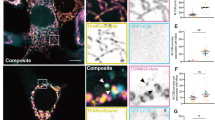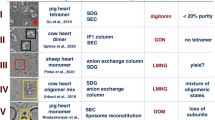Abstract
Pro- and anti-apoptotic members of the Bcl-2 family control the permeability of the outer mitochondrial membrane. They could do this either by forming autonomous pores in the membrane or by collaborating with components of the permeability transition pore. Here we discuss why we favour the first of these possibilities.
This is a preview of subscription content, access via your institution
Access options
Subscribe to this journal
Receive 12 print issues and online access
$189.00 per year
only $15.75 per issue
Buy this article
- Purchase on Springer Link
- Instant access to full article PDF
Prices may be subject to local taxes which are calculated during checkout


Similar content being viewed by others
References
Desagher, S. & Martinou, J.-C. Mitochondria as the central control point of apoptosis. Trends Cell Biol. 10, 369–377 (2000).
Nicotera, P. & Leist, M. Energy supply and the shape of death in neurons and lymphoid cells. Cell Death Differ. 4, 435–442 (1997).
Chautan, M., Chazal, G., Cecconi, F., Gruss, P. & Golstein, P. Interdigital cell death can occur through a necrotic and caspase-independent pathway. Curr. Biol. 9, 967–970 (1999).
Du, C., Fang, M., Li, Y., Li, L. & Wang, X. Smac, a mitochondrial protein that promotes cytochrome c-dependent caspase activation by eliminating IAP inhibition. Cell 102, 33–42 (2000).
Verhagen, A. M. et al. Identification of DIABLO, a mammalian protein that promotes apoptosis by binding to and antagonizing IAP proteins. Cell 102, 43–53 (2000).
Susin, S. A. et al. Molecular characterization of mitochondrial apoptosis-inducing factor. Nature 397, 441–446 (1999).
Hsu, Y.-T., Wolter, K. G. & Youle, R. J. Cytosol-to-membrane redistribution of Bax and Bcl-xL during apoptosis. Proc. Natl Acad. Sci. USA 94, 3668–3672 (1997).
Suzuki, M., Youle, R. J. & Tjandra, N. Structure of Bax: Coregulation of dimer formation and intracellular localization. Cell 103, 645–654 (2000).
Wei, M. C. et al. tBID, a membrane-targeted death ligand, oligomerizes BAK to release cytochrome c. Genes Dev. 14, 2061–2071 (2000).
Perez, D. & White, E. TNF-α signals apoptosis through a Bid-dependent conformational change in Bax that is inhibited by E1B19K. Mol. Cell 6, 53–63 (2000).
Puthalakath, H., Huang, D. C. S., O'Reilly, L. A., King, S. M. & Strasser, A. The proapoptotic activity of the Bcl-2 family member Bim is regulated by interaction with the dynein motor complex. Mol. Cell 3, 287–296 (1999).
Goldstein, J. C., Waterhouse, N. J., Juin, P., Evan, G. I. & Green, D. R. The coordinate release of cytochrome c during apoptosis is rapid, complete and kinetically invariant. Nature Cell Biol. 2, 156–162 (2000).
Muchmore, S. W. et al. X-ray and NMR structure of human Bcl-xL, an inhibitor of programmed cell death. Nature 381, 335–341 (1996).
Chou, J. J., Honglin, L., Salvesen, G. S., Yuan, J. & Wagner, G. Solution structure of Bid, an intracellular amplifier of apoptotic signaling. Cell 96, 615–624 (1999).
McDonnell, J. M., Fushman, D., Milliman, C. L., Korsmeyer, S. J. & Cowburn, D. Solution structure of the proapoptotic molecule Bid: a structural basis for apoptotic agonists and antagonists. Cell 96, 625–634 (1999).
Shimizu, S. & Tsujimoto, Y. Proapoptotic BH3-only Bcl-2 family members induce cytochrome c release, but not mitochondrial membrane potential loss, and do not directly modulate voltage-dependent anion channel activity. Proc. Natl Acad. Sci. USA 97, 577–582 (2000).
von Ahsen, O. et al. Preservation of mitochondrial structure and function after Bid- or Bax-mediated cytochrome c release. J. Cell Biol. 150, 1027–1036 (2000).
Chai, J. C. et al. Structural and biochemical basis of apoptotic activation by Smac/DIABLO. Nature 406, 855–862 (2000).
Antonsson, B., Montessuit, S., Lauper, S., Eskes, R. & Martinou, J.-C. Bax oligomerization is required for channel-forming activity in liposomes and to trigger cytochrome c release from mitochondria. Biochem. J. 345, 271–278 (2000).
Gross, A., Jockel, J., Wei, M. C. & Korsmeyer, S. J. Enforced dimerization of BAX results in its translocation, mitochondrial dysfunction and apoptosis. EMBO J. 17, 3878–3885 (1998).
Cheng, E. H.-Y. et al. Conversion of Bcl-2 to a Bax-like death effector by caspases. Science 278, 1966–1968 (1997).
Saito, M., Korsmeyer, S. J. & Schlesinger, P. H. Bax-dependent transport of cytochrome c reconstitued in pure liposomes. Nature Cell Biol. 2, 553–555 (2000).
Gilbert, R. J. C. et al. Two structural transitions in membrane pore formation by pneumolysin, the pore-forming toxin of Streptococcus pneumoniae. Cell 97, 647–655 (1999).
Bernardi, P., Scorrano, L., Colonna, R., Petronilli, V. & Di Lisa, F. Mitochondria and cell death. Eur. J. Biochem. 264, 687–701 (1999).
Crompton, M. The mitochondrial permeability transition pore and its role in cell death. Biochem. J. 341, 233–249 (1999).
Eskes, R., Desagher, S., Antonsson, B. & Martinou, J.-C. Bid induces the oligomerization and insertion of Bax into the outer mitochondrial membrane. Mol. Cell. Biol. 20, 929–935 (2000).
Marzo, I. et al. Bax and adenine nucleotide translocator cooperate in the mitochondrial control of apoptosis. Science 281, 2027–2031 (1998).
Shimizu, S., Narita, M. & Tsujimoto, Y. Bcl-2 family proteins regulate the release of apoptogenic cytochrome c by the mitochondrial channel VDAC. Nature 399, 483–487 (1999).
Shimizu, S., Ide, T., Yanagida, T. & Tsujimoto, Y. Electrophysiological study of a novel large pore formed by Bax and the voltage-dependent anion channel that is permeable to cytochrome c. J. Biol. Chem. 275, 12321–12325 (2000).
Shimizu, S., Konishi, A., Kodoma, T. & Tsujimoto, Y. BH4 domain of antiapoptotic Bcl-2 family members closes voltage-dependent anion channel and inhibits apoptotic mitochondrial changes and cell death. Proc. Natl Acad. Sci. USA 97, 3100–3105 (2000).
Vander Heiden, M. G., Chandel, N. S., Schumacker, P. T. & Thompson, C. B. Bcl-xL prevents cell death following growth factor withdrawal by facilitating mitochondrial ATP/ADP exchange. Mol. Cell 3, 159–167 (1999).
Vander Heiden, M. G. et al. Outer mitochondrial membrane permeability can regulate coupled respiration and cell survival. Proc. Natl Acad. Sci. USA 97, 4666–4671 (2000).
Zhuang, J., Dinsdale, D. & Cohen, G. M. Apoptosis, in human monocytic THP.1 cells, results in the release of cytochrome c from mitochondria prior to their ultracondensation, formation of outer membrane discontinuities and reduction in inner membrane potential. Cell Death Differ. 5, 953–962 (1998).
Kroemer, G., Dallaporta, B. & Resche-Rigon, M. The mitochondrial death/life regulator in apoptosis and necrosis. Annu. Rev. Physiol. 60, 619–642 (1998).
Gross, A. et al. Biochemical and genetic analysis of the mitochondrial response of yeast to Bax and Bcl-xL . Mol. Cell. Biol. 20, 3125–3136 (2000).
Priault, M., Chaudhuri, B., Clow, A., Camougrand, N. & Manon, S. Investigation of Bax-induced release of cytochrome c from yeast mitochondria. Eur. J. Biochem. 260, 684–691 (1999).
Kissova, I. et al. The cytotoxic action of Bax on yeast cells does not require mitochondrial ADP/ATP carrier but may be related to its import to the mitochondria. FEBS Lett. 471, 113–118 (2000).
Priault, M., Camougrand, N., Chaudhuri, B., Schaeffer, J. & Manon, S. Comparison of the effects of Bax-expression in yeast under fermentative and respiratory conditions: investigation of the role of adenine nucleotides carrier and cytochrome c. FEBS Lett. 456, 232–238 (1999).
Pastorino, J. G., Chen, S.-T., Tafani, M., Snyder, J. W. & Farber, J. L. The overexpression of Bax produces cell death upon induction of the mitochondrial permeability transition. J. Biol. Chem. 273, 7770–7775 (1998).
Bossy-Wetzel, E., Newmeyer, D. D. & Green, D. R. Mitochondrial cytochrome c release in apoptosis occurs upstream of DEVD-specific caspase activation and independently of mitochondrial transmembrane depolarization. EMBO J. 17, 37–49 (1998).
Zhivotovsky, B., Orrenius, S., Brustugun, O. T. & Doskeland, S. O. Injected cytochrome c induces apoptosis. Nature 391, 449–450 (1998).
Deshmukh, M. & Johnson, E. M. Evidence of a novel event during neuronal death: development of competence-to-die in response to cytoplasmic cytochrome c. Neuron 21, 653–655 (1998).
Green, D. Apoptotic pathways: papers wraps stone blunts scissors. Cell 102, 1–4 (2000).
Desagher, S. et al. Bid-induced conformational change of Bax is responsible for mitochondrial cytochrome c release during apoptosis. J. Cell Biol. 144, 891–901 (1999).
Knudson, C. M. & Korsmeyer, S. J. Bcl-2 and Bax function independently to regulate cell death. Nature Genet. 16, 358–363 (1997).
Kane, D. J., Ord, T., Anton, R. & Bredesen, D. E. Expression of Bcl-2 inhibits necrotic neuronal cell death. J. Neurosci. Res. 40, 269–275 (1995).
Acknowledgements
We thank B. Antonsson, S. Desagher, M. Koco–Vilbois, K. Maundrell, S. Montessuit, O. Terradillos and X. Roucou for critical reading of the manuscript.
Author information
Authors and Affiliations
Rights and permissions
About this article
Cite this article
Martinou, JC., Green, D. Breaking the mitochondrial barrier. Nat Rev Mol Cell Biol 2, 63–67 (2001). https://doi.org/10.1038/35048069
Issue Date:
DOI: https://doi.org/10.1038/35048069
This article is cited by
-
Critical roles of tubular mitochondrial ATP synthase dysfunction in maleic acid-induced acute kidney injury
Apoptosis (2024)
-
A novel protein extracted from Hemerocallis citrina Borani inhibits hepatocellular carcinoma cell proliferation by regulating mitochondria-dependent apoptosis and aerobic glycolysis
Food Science and Biotechnology (2024)
-
Intrinsic and extrinsic apoptosis responses in leukaemia cells following daunorubicin treatment
BMC Cancer (2021)
-
Transcriptome analysis of arterial and venous circulating miRNAs during hypertension
Scientific Reports (2021)
-
Targeting cellular batteries for the therapy of neurological diseases
Environmental Science and Pollution Research (2021)



